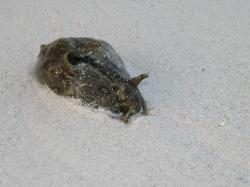

| Caminando por la playa el otro dia pise algo mocoso y esponjoso e inmediatamente di el brinco, completamente asqueado por la sensación en la planta del píe, la cual estaba cubierta de un líquido púrpura. De inmediato me la enjuague en el mar y buscando a la causa de tan desagradable episodio me encontre con una enorme babosa de mar, mas o menos del tamaño de mi mano. Aunque había sido varada y pisada, seguía moviéndose, por lo que la empujé de vuelta al agua con un palo antes de continuar mi recorrido. No llegue muy lejos. Había decenas de estas babosas en la playa, algunas median apenas 2 o 3 centímetros, otras cerca de 20, como la que pisé. Después cuando salí a nadar me topé con cientos de ellas a escasos metros de la orilla. Jamás les había visto antes, así que decidí investigar. Resulta que es una Liebre de Mar, con nombre científico de Aplysia dactylomela. Aparentemente son bastante comunes y se les encuentra en todo el mundo, y se alimentan de algas, lo cual es bueno porque tenemos demasiadas algas. Pero curiosamente todas las fuentes que consulté indicaban que son animales nocturnos- lo cual quizá explique porqué jamás les había visto antes. Sin embargo, este día abundaban a plena luz del sol, y se divertían bastante. Son hermafroditas, y durante el apareamiento actúan como macho y hembra simultáneamente, formando cadenas de varios individuos. Tristemente, para cuando regrese con la camara al día siguiente, la mayoría habían muerto. Pero la buena noticia es que son inofensivos y el líquido púrpura con que chorreo mi pie es inocuo, algo así como la tinta de un calamar. Ah, y aparentemente son utilizados para investigaciones neurológicas, ya que tienen una neurona gigante en el abdomen que se parece a la de invertebrados. ¿Que tal? |
Liebre de Mar
Spotted Sea Hare
Aplysia dactylomela
Spotted Sea Hare
Aplysia dactylomela
| Walking down the beach the other day I stepped on something slimy and soft, and immediately jumped back completely grossed out by the icky feeling of yuck on the sole of my foot, which was covered in purple liquid. I immediately rinsed it off and then looked back for the cause of such a disgusting episode and found a rather large sea slug, about as big as my hand. Even though it was beached and had been stepped on, it still seemed to be moving, so I found a stick and pushed it back in the water before continuing with my walk. I didn't get very far. There were dozens all over the beach, from just over an inch to the six inch monster I accidentally squashed. Later when I went for a swim I found hundreds of not too far from the shore. I had never seen these creatures before, so I decided to look them up. It turns out they are called Sea Hares, and this particular variety is the Spotted (Aplysia dactylomela). They seem to be fairly common and found worldwide, and feed on algae, which is good, because we have way too much algae. But strangely enough the references I checked all claimed them to be nocturnal animals- which may account for why I'd never seen them before. This day however they were out in abundance- and partying. They are hermaphrodites, and while mating they act as both male and female, sometimes forming chains of several individuals. Sadly, when I went back with the camera the next day, most had died. But the good news is, they are harmless and the purple discharge which briefly graced my foot is harmless, sort of like squid ink. Oh and apparently they are also commonly used in neurological research, because of a giant abdominal neuron which is similar to that of vertebrates. Cool. |
| Photos, video and text by David Nuñez |
| Recomendamos estos libros sobre la Fauna de México. (Los nuestros son bilingues.) |
| To learn more about the Wildlife of Mexico, we recommend the following books. |













